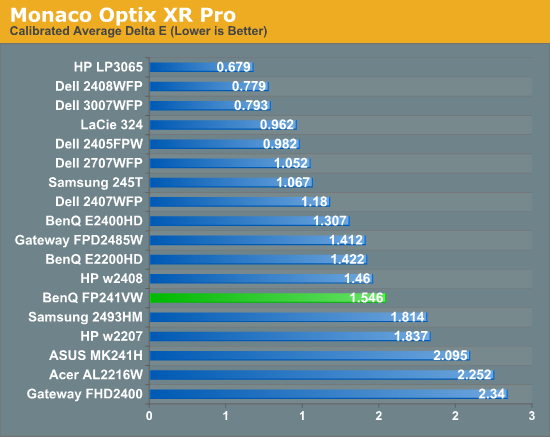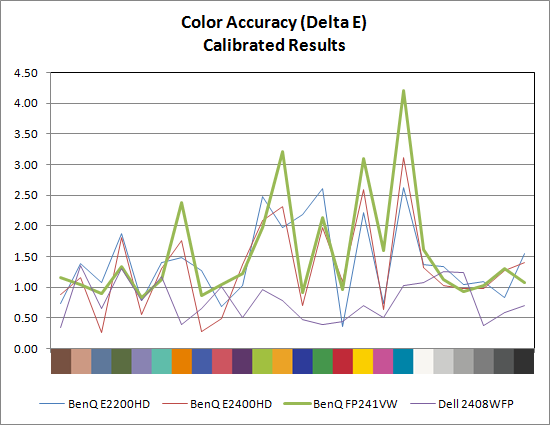Color Accuracy
Imaging professionals definitely like to have accurate colors, and the best way of assuring that your display shows the proper colors is to use a colorimeter and calibration software. However, not everyone has access to such tools and many users are unwilling to spend over $200, so we calibrate and test the various LCDs. We didn't perform a thorough evaluation of color accuracy on the FP241VW, so we will limit our Delta E comparison to calibrated performance where we target a white level of ~200 nits - anything more than that is too bright in our opinion. The FP241VW actually ended up at 270 nits, but that won't substantially affect any of the scores. Before we get to the results, here are the display settings we used on the BenQ LCDs. We let the LCDs stabilize for at least one hour before performing measurements. We will compare results with the Dell 2408WFP, which so far has achieved the best overall color accuracy of any LCD we have tested, as well as the previous two BenQ LCDs.
| LCD Brightness and Contrast Settings | ||
| Standard Calibrated (~200 nits) | Calibrated for Print (~100 nits) | |
| BenQ E2200HD | 65 Brightness, 50 Contrast "Normal" (95-95-95 RGB) |
20 Brightness, 50 Contrast "Normal" (95-95-95 RGB) |
| BenQ E2400HD | 73 Brightness, 50 Contrast "Normal" (94-94-91 RGB) |
30 Brightness, 50 Contrast "Normal" (94-94-91 RGB) |
| BenQ FP241VW | 35 Brightness, 50 Contrast (270 nits) "Normal/sRGB" (47-48-45 RGB) |
N/A |


After calibration, the FP241VW still fails to come anywhere close to the Dell 2408WFP - and in fact it doesn't even match the accuracy of the less expensive E2400HD. That said, it's interesting to note that the color accuracy curves for all three BenQ LCDs are extremely similar, to the point where I now have to wonder if backlighting has a far greater impact on color accuracy than I previously thought. It makes sense that better backlighting would allow the panels to achieve better color accuracy, but I don't have any evidence for this assertion other than the above chart. Anyone serious about color accuracy is probably going to want an average Delta E of around 1.0 or less post-calibration. So far, only S-PVA and S-IPS panels achieve that goal, although it's possible a better backlight would allow the A-MVA display to match the other displays. Note also how the bottom half of the above chart is dominated by LCDs that use TN panels.










114 Comments
View All Comments
erple2 - Wednesday, June 17, 2009 - link
I bought the hp 2475w to replace my old Dell 2001FP model. I don't have any complaints about it. The color is better than the Dell was. I wound up using both monitors, however, as I have the space on my desktop for both of those monitors. It's nice to have the side monitor (relegating the 2001FP to side monitor ... heh heh) for "other tasks" while focusing on the main monitor. Plus, they're about the same vertical size.Again, I haven't noticed any real complaints with the 2475w beyond what I'd also complain about the 2001FP. In fact, the brightness appears better and more uniform.
Mastakilla - Wednesday, June 17, 2009 - link
Are you crazy?I (and I hope smarter people allow me to say "we") do NOT want high color gamut, because there is simply no support for it...
until it is supported on OS level, 99% of the applications that 99% of the people use simply look like crap :(
stop supporting this wide gamut bullshit please!!
I want to see what I'm supposed to see and not some over saturated crap
and even if you are a graphics artist using correct wide gamut hardware / software: what is the point in it? 99% of the people will see the image wrong anyway...
haplo602 - Wednesday, June 17, 2009 - link
graphic artists prepare photos for PRINT not web viewing :-)also a proper wide gamut monitor has an sRGB mode where the colors match (or should match) sRGB, no oversaturated colors.
bigboxes - Wednesday, June 17, 2009 - link
The OP is misinformed. A wide color gamut is very important for color accuracy. Maybe not for the casual user, but definitely to the content creator.The0ne - Thursday, June 18, 2009 - link
Hence that's why I think most of the users commenting here aren't really in the business to even use, appreciate or know what they're getting. It's all about having the best but now knowing what to do with it. That's just my opinion of course.Now before anyone starts getting upset, I am still in the printing business dealing with credit cards and checks. I can tell you from numerous research and seminars that most people really don't care, don't know or don't appreciate what some of these technologies provide. And rightly so because it's a niche market.
10e - Wednesday, June 17, 2009 - link
You said "In the case of the FP241VW, color accuracy and color gamut are lower than average, but that a better backlight could address that shortcoming."I'd agree the factory accuracy of the FP241VW is not good, but the fact that it was always a standard gamut display is/was an advantage. We get caught up in numbers and forget that in regards to gamut, for 99% of the users out there sRGB gamut is more than good enough, and is preferable to the over saturated reds and greens of wide gamut panels, which is something that so far even Windows 7 has not been able to properly address.
10e - Wednesday, June 17, 2009 - link
In my experience the Samsung S-PVA panels used in these monitors lag: Dell 2408WFP, 2709W, Samsung 245T, 275T Plus. There is noticeable input lag where the mouse cursor plays "catch up" with what the mouse hand is doing. I had an FP241VW and it never displayed this characteristic in DVI or VGA. It goes to show that some people will notice it, and others won't.darklight0tr - Wednesday, June 17, 2009 - link
I understand, but it is getting tiring to constantly get beaten over the head with that info, as is done in this article.I think PVA gets a bad rap, and I think the lag has more to do with the image scalers than it does with the panel technology itself. Just look at the reviews for the S-IPS 3008WFP. There are the same complaints from a few users about input lag on that display, and one of the main changes from the 3007WFP was the addition of an image scaler. All of the PVA displays you mention have scalers as well.
That said, despite all of the hype you read on the Internet over lag, there are probably tons of very happy PVA users (including myself) playing games on their PVA displays, oblivious to any lag.
jabber - Thursday, June 18, 2009 - link
Indeed I have two Samsung 214T 21" 4:3 PVA panels and they are super sharp and I see no ghosting or 'catch up' whatsoever.Running through COD4/BF2/EVE etc. etc.
As stated above I dont think its the panels. I reckon its the case of more expensive panel so often the manufacturer will cut corners on the other electronics inside to make it hit a price point.
PVA's are fine. However, as with any monitor purchase, if you are serious about screen quality...do your homework!
jabber - Wednesday, June 17, 2009 - link
Been using PVA screens pretty exclusively for gaming for around 3 years now. Havent noticed or seen any performance/screen lag issues in all that time.Maybe you are thinking back to the turn of the century screens?
Certainly isnt an issue in my opinion.